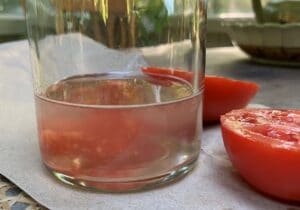Hello Fellow Readers, The idea of saving vegetable seeds came to me a few years back while buying produce at a farm market. One tomato weighed in at five bucks. True, it was a beefy one. When I shared my sticker shock, the farmer said it was an heirloom tomato grown organically. And so, I made the purchase and saved some seeds to justify the ‘investment.’
What are heirloom seeds, and are they organic?
Some define heirloom seeds as those open-pollinated (by wind or insects) that date back forty to fifty years; others say before World War II, which began in 1939. It turns out many heirlooms can be organic as they came before synthetic fertilizers and pesticides. Heirloom seeds can be collected from the parent plant year to year and produce the same characteristics, unlike hybrids or GMOs.
Organic vegetables are grown following the USDA’s National Organic Program (NOP), which doesn’t allow synthetic pesticides and fertilizers, sewage sludge (biosolids), or fresh manure. And they must be non-GMO – not genetically modified.
Save open-pollinated seeds versus hybrids
So back to saving seeds. Choose open-pollinated seeds, or plants that self-pollinate, rather than hybrids, as hybrids will not necessarily reproduce to be the same as the mother plant. Hybrids are a cross-pollination of two different varieties of plants from the same species. It’s a process that happens in nature, though plant breeders intentionally cross-pollinate plants to improve characteristics such as disease resistance, color, fruit sizes, or improved taste and yields. Hybrids can be organic.
Plants that need to cross-pollinate—in other words, have male and female flowers such as squash, corn, and watermelon—tend to hybridize with different varieties making saving seeds and keeping a pure variety challenging.
 The most straightforward vegetable seeds to save:
The most straightforward vegetable seeds to save:
Some of the most straightforward vegetable seeds to save are tomato, peppers, beans, and peas. Once the tomato is fully ripe, scoop out the gooey center with the seeds and put them a jar with water. Swirl them around periodically for a few days to separate the gel from the seeds. Then pour the liquid away and rinse the seeds.
Allow peppers to ripen and start to wither on the plant before harvesting the seeds—dry tomato and pepper seeds on paper towels for a few weeks.
For peas and beans, let them ripen on the plants until they dry and turn brown. If frost is pending before they brown, pull out the plants and hang them upside down in a warm, dry space such as a basement or shed. The seeds will draw energy from the plant until its dry. Harvest the pods and spread them out on a tray indoors to dry. Or better yet, you can wait until the following spring to shell the pods and sow the seeds. Easy Peezy.
Make sure seeds are thoroughly dry before storing them in airtight containers to keep critters out and moisture from ruining the seeds by encouraging mold. Of course, label them and the date when you harvested them so that you can monitor your results and keep track of the best producing seeds from year to year. There’s nothing like the fun of gathering “free” seeds and watching them grow into nutritious veggies. Garden Dilemmas? AskMaryStone@gmail.com (and now on your favorite Podcast App.)
You’ll enjoy a previous column titled The Magic of Seeds
Can you grow seeds from grocery vegetables?
Joann of Fredon NJ asked if it’s safe to save seeds from vegetables bought at the grocery store. If they are organic, I’d say so, but of course, you won’t know if they are hybrids. And it’s tough to tell if conventionally grown vegetables are non-GMO unless they labeled as such, which is voluntary and very unlikely. Keep in mind, many GMO crops grown in the United States are genetically engineered to resist chemical pesticides such as controversial Roundup.
Things you should know about produce labeling:
There are small stickers on fruits and vegetables with a price lookup code (PLU code). Organically grown fruits and vegetable PLU’s have five digits that start with the number 9. Conventionally grown, meaning synthetic pesticides and fertilizers were used to prevent disease and enhance growth, have only four digits. If there are more than five digits in the number, it’s not a PLU that follows the internationally standardized system.
We look forward to the day where food labeling is more transparent. The deadline to comply with the USDA’s National Bioengineered Food Disclosure Standard making it mandatory to disclose foods using GMO ingredients, is January 1st, 2022. Many foods using GMO ingredients will have to be labeled “bioengineered.”



